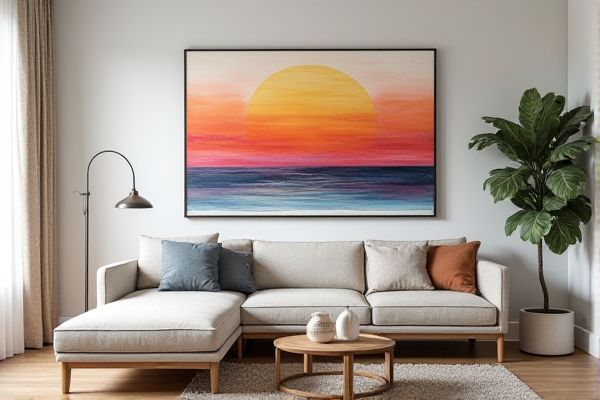
Horizontal art emphasizes width and broad perspectives, often evoking calmness and openness, while vertical art highlights height and structure, conveying strength and aspiration. Explore the rest of the article to discover how the orientation of your artwork influences its emotional impact and aesthetic appeal.
Table of Comparison
| Aspect | Horizontal Art | Vertical Art |
|---|---|---|
| Orientation | Wide, landscape format | Tall, portrait format |
| Common Uses | Landscapes, panoramas, group portraits | Portraits, architectural designs, tall structures |
| Visual Impact | Conveys stability, calmness, expansiveness | Suggests height, elegance, motion |
| Viewing Experience | Encourages eye movement left to right | Focuses attention upward or downward |
| Space Utilization | Suitable for wide spaces and screens | Fits narrow spaces and tall walls |
Introduction to Horizontal and Vertical Art
Horizontal art captures expansive landscapes and wide scenes, emphasizing width and often evoking a sense of calm or stability. Vertical art highlights height and depth, drawing the viewer's eye upward or downward to emphasize growth, power, or spiritual themes. Both orientations influence composition, mood, and spatial perception, shaping how artwork communicates its message.
Defining Horizontal Art: Characteristics and Examples
Horizontal art emphasizes width over height, featuring landscapes, panoramic scenes, and wide compositions that evoke a sense of calm and openness. Characteristics include extended, low horizons and balanced spatial elements that guide the viewer's eye laterally across the canvas, often seen in works like Claude Monet's "Water Lilies" or panoramic cityscapes. Your appreciation of horizontal art may deepen through understanding how these elements create immersive visual experiences.
Vertical Art Explained: Features and Impact
Vertical art emphasizes height and upward movement, often creating a sense of grandeur and aspiration through elongated forms and compositions. This format enhances visual impact by drawing the viewer's eye along a vertical axis, which can evoke feelings of strength, spirituality, or growth, commonly found in architectural designs and religious iconography. Its distinct spatial orientation contrasts with horizontal art by focusing on elevation and depth, influencing both emotional response and spatial perception in art and design.
Historical Evolution of Art Orientation
Horizontal art has deep roots in prehistoric cave paintings and ancient murals, where wide landscapes and storytelling scenes preferred a panoramic format to capture expansive environments. Vertical art gained prominence during the Renaissance and Baroque periods, emphasizing religious and portraiture subjects that required elongated compositions to convey spiritual elevation or human stature. Understanding the historical evolution of art orientation helps you appreciate how artists adapted formats to cultural, thematic, and spatial demands across different eras.
Psychological Effects: Horizontal vs. Vertical Compositions
Horizontal compositions evoke feelings of calmness, stability, and relaxation by mimicking natural horizons and landscapes. Vertical compositions convey strength, growth, and dynamic energy, often drawing the viewer's gaze upward and suggesting ambition or spirituality. These psychological effects influence how viewers emotionally connect with art, shaping interpretations based on orientation.
Space Utilization: Choosing the Right Orientation
Horizontal art maximizes wide spaces, making it ideal for large walls or rooms with expansive layouts, enhancing visual flow and balance. Vertical art draws the eye upward, perfect for narrow walls or high ceilings, effectively utilizing limited width and emphasizing height. Your choice of orientation should align with the available space and desired aesthetic impact for optimal room harmony.
Artistic Techniques for Each Orientation
Horizontal art often employs expansive compositions and panoramic perspectives, utilizing techniques like wide brushstrokes and layering to emphasize breadth and storytelling across a landscape. Vertical art focuses on height and depth, frequently incorporating elongated lines, stacking elements, and vertical symmetry to draw the viewer's eye upward and create a sense of grandeur or spiritual ascent. Techniques such as foreshortening and linear perspective are adapted uniquely in each orientation to enhance spatial dynamics and viewer engagement.
Popular Genres: Landscape vs. Portrait Art
Horizontal art predominantly features landscape genres, capturing expansive scenes such as nature vistas, cityscapes, and panoramic views that emphasize width and spatial depth. Vertical art is closely associated with portrait genres, focusing on human figures or singular subjects, highlighting height and detailed expressions within a narrow frame. The orientation directly influences composition and storytelling, with horizontal layouts enhancing environmental context while vertical formats concentrate on individual character and emotion.
Display Considerations: Framing and Placement
Horizontal art often suits wide walls and low furniture, allowing for expansive frames that enhance spatial width and naturally guide viewer attention across the piece. Vertical art works well in narrow or taller spaces, with framing that emphasizes height and draws the eye upward, ideal for accentuating ceiling height or filling slim wall areas. Your choice of framing and placement should align with the room's dimensions and focal points to create harmonious visual balance and complement the surrounding decor.
Conclusion: Selecting the Ideal Art Orientation
Choosing between horizontal and vertical art hinges on the intended spatial impact and room dimensions; horizontal art enhances width perception in wider spaces, while vertical art accentuates height in narrower or taller rooms. Consider the furniture arrangement and wall size to ensure balance and visual harmony. Optimal art orientation aligns with architectural features and personal aesthetic preferences, maximizing both functionality and artistic expression.
 homyna.com
homyna.com